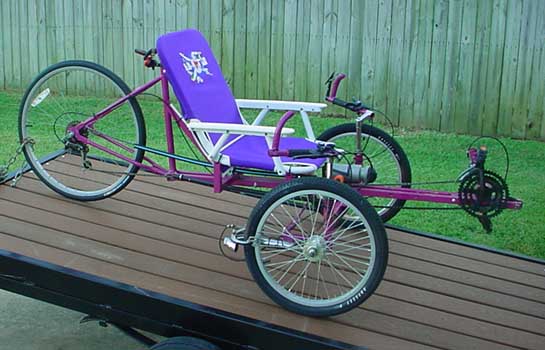|
The Recumbent Bike:
|
|
|
Three of the more remarkable characteristics of trikes include . . .
1. You do not need to disengage the pedals when stopped.
2. Trikes can be geared very low, enabling steep climbing while heavily loaded and at slow speed — without losing stability.
3. They are capable of turning sharply without leaning.
(As with uprights, there is a subculture of riders who design and build their own recumbent bikes. Often these are assembled with parts from other bikes. The frame design may be as simple as a long steel tube bent into the right shape or as elaborate as hand-built carbon fiber frames. For many builders, the engineering and construction of the trikes is as challenging and as much fun as riding them.

The trike shown here was designed and built by Florida resident and retired U.S. Air Force officer, Dennis Ewert. Its seat is a recycled lawn chair! Pretty slick.)
Here are some advantages over upright bicycles . . .
•Variety: Specific recumbent bike models can be found that best meet the physical needs and aesthetic preferences of the buyer. Models range from semi-upright to full recline and from short wheelbase to long wheelbase.
•Safety: The low center of gravity and closeness to the ground reduce the consequences of a fall. Falls may also be less serious than from an upright because of the feet first orientation. You are much less likely to go over the handlebars, resulting in fewer head injuries.
•Comfort: The riding position reduces strain, making it easy on your neck, wrists, hands, arms, shoulders, and lower-back. Riders suffering from back pain or genito-urinary problems may find they can take longer rides without pain.
•View: The riding position faces forward at a comfortable angle for looking at passing scenery. Uprights, particularly road bikes, place you in a riding position where the natural angle is to stare down at the pavement. To look at the scenery, your neck must be craned upward.
•Health: The inherent stability of three wheels allows very low gearing so that you can climb hills without joint strain. On some recumbents, your legs are nearly the same level as your heart, allowing reduced hydrostatic pressure and letting venous blood more easily return to your heart. The physiological effect of improved circulation suggests increased endurance on long rides.
•Speed: On declines, on the flat, or on shallow inclines, recumbents are generally faster than uprights with a rider making the same level of effort. The aerodynamic profile of the rider reduces wind resistance. (It is this feature that led to the Union Cycliste Internationale banning them from racing in 1934).
Still, they are not perfect. (What is?) A few disadvantages include . . .
•Recumbent riders cannot shift their weight to steer or help balance, as upright riders can.
•Starting and Stopping: Uprights can be propelled forward by a rider’s foot on the ground. Recumbents can only be propelled forward using the pedals. Starting does not require great strength but there is a matter of balance and skill that must be learned.
•Maneuverability: Uprights can turn in a much smaller radius.
•Steep Inclines: Upright riders can stand and pedal on ascents for more leg drive.
|
|
2. Stationary Recumbents are found in home gyms and health clubs. Like upright stationary exercise bikes, they stay in place as you pedal against a resistance mechanism while in a recumbent position.
They have the same comfort level as the road-going types and are excellent for cardiovascular exercise that is also “joint friendly.”
Most have a fairly upright seat and a pedal crank that is at a slightly lower level than the seat. The seat is usually adjustable by sliding it along a rail and locking it in place.
Many stationary machines feature heart rate monitors you access by holding two side handles. Many also have programmable exercise formats, such as hill climbing, intervals, endurance rides, and random speeds.
Retrun from Recumbent Bike to Cardio is Essential for Seniors